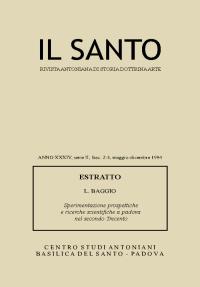Sperimentazioni prospettiche e ricerche scientifiche a Padova nel secondo Trecento.

estratto da "Il Santo", XXXIV (1994), 2-3
SOMMARIO
Partendo dalla testimonianza quattrocentesca di Michele Savonarola, che individua nell'opera dei pittori trecenteschi padovani una dimostrazione pratica delle scienze della visione, si propone in questo studio un 'indagine parallela tra i risultati degli scienziati e quelli degli artisti attivi a Padova nel XIV secolo. In particolare si individuano alcune caratteristiche delle ricerche di Giovanni Dondi e di Biagio Pelacani, quali l'uso della matematica nella conoscenza dello spazio e l'interesse per il concetto di vuoto spaziale, che sembrano in sintonia con le sperimentazioni prospettiche degli artisti. Il rapporto dipinto-spettatore, la concezione di uno spazio costruito a priori, la misurabilità degli edifici, che nasce da preventivi calcoli geometrico-matematici, diventano campi di indagine continua nei pittori padovani dagli anni sessanta in poi. Queste ricerche sono individuate nell'opera di Guariento e nei cicli affrescati da Giusto de' Menabuoi e Altichiero, ponendo in luce da un lato il legame esplicito con Giotto, dall'altro i contributi originali dei tre artisti, che preludono agli sviluppi del rinascimento toscano.
SUMMARY
Taking as a starting point Michele Savonarola 's 15th century view that the works of art of the 14th century Paduan painters represent a practical demonstration of perspective sciences, this study covers a paraZZel survey of the results of the work carried out by the scientists and artists who were active in Padua in the 15th century. Certain characteristic of the research of Giovanni Dondi and Biagio Pelacani have been identified; in particular, their use of mathematics in the knowledge of space and their interest in the concept of vacuums, which seem to be on the sa me wavelength as the experiments carried out on prospectives by the artists. The relationship between the painting and the viewer, the conception of a pre-created space and the ability to measure buildings that have been designed according to geometrical and mathematical calculations became fields of continuous research for the Paduan painters from the 1360s onwards. This research has been identified in Guariento's work and Giusto de Menabuoi's and Altichiero's fresco cycles, bringing to light, on the one hand, the clear link with Giotto and, on the other, the originaI contribution of the three artists who foreshadowed the developments of the Tuscan Renaissance.

